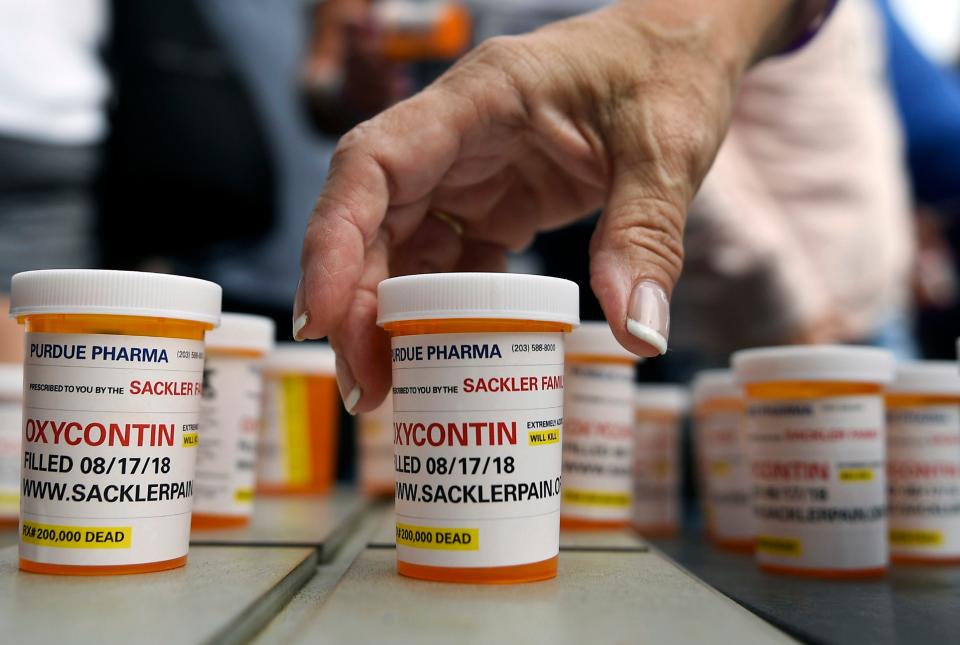Opioid settlements are imminent. Spend the money on proven treatments that save lives.
The bill is finally coming due for companies that profited from addiction and death. State officials announced Wednesday that four companies are poised to reach a $26 billion settlement with more than 3,000 local governments for their role in fueling the overdose crisis. Purdue Pharma is notably absent, but the notorious firm and the Sackler family that owns it are embroiled in a separate bankruptcy case in which they are likely to pay out $4.5 billion. It could be approved next month.
The looming settlements raise urgent questions: How will funds from Purdue and other companies that stoked the overdose crisis be spent, and how might we end the grievous suffering and loss that they unleashed?
Some lawsuits may be over, but the overdose crisis is not. It has claimed over 930,000 lives since 1999. Millions of Americans who lost friends and family members see little hope for justice and few safeguards to prevent a crisis like this from happening again. And those who struggle with substance use disorders face overwhelming barriers to treatment, leaving them at serious risk of overdose and death.
A flood of resources coming
In many ways, the crisis is worse than ever. Largely due to the COVID-19 pandemic, drug overdoses of all kinds took more than 93,000 lives last year – a 29% increase from 2019. The future looks grim, but still there is reason to be hopeful. The opioid settlements and several ongoing lawsuits could ultimately generate $50 billion or more, flooding struggling communities with resources. These funds cannot compensate for our tragic collective loss, but they can be used to help those who are suffering. Where will that money go?
Those of us who remember the tobacco settlements in the late 1990s know that a financial windfall does not always go to those who need the most help. States received $206 billion, almost none of which went to reducing smoking harms.
Plaintiffs in the opioid cases have promised that opioid settlement funds will help prevent and treat opioid use disorders. This strategy sounds good on the surface, but a deeper dive suggests it might not have the desired outcome.

States serious about reducing overdose deaths should devote most of their funds to harm reduction and evidence-based treatment. Harm reduction strategies – those predicated on meeting people where they are and encouraging positive change – have proved effective in reducing overdose deaths. These approaches include syringe provision programs, naloxone distribution programs and supervised consumption services.
Congressman Trone: Spend the opioid settlement funds to prevent more deaths like my nephew's
States must also overcome obstacles to medical treatment. Two of the most effective treatments for opioid use disorder – buprenorphine and methadone – are largely inaccessible. Fewer than 10% of primary care providers in the United States are approved to prescribe buprenorphine, while methadone access is severely restricted by law.
Research has shown that buprenorphine access can be expanded by enlisting health care providers like nurse practitioners and pharmacists, and methadone access can be expanded by relaxing strict laws. States should devote their efforts to expanding access to care that works.
Funnel money to programs that work
However, states make a grave error if they simply fund existing programs without considering their quality or effectiveness and if they remove programs that have proved effective. The treatment industry is vast and varied. Predatory, for-profit treatment centers exist alongside evidence-based programs. And some treatment programs do worse than fail – they provide no real treatment and release patients with a reduced drug tolerance that increases the risk of overdose.
We are unlikely to bring down overdose rates if ineffective or harmful programs receive the same portion of funding as evidence-based treatment programs.
At the same time, many cities and states are working at cross purposes. They are promising to use settlement funds to save lives while at the same time dismantling programs that do just that. The recent wave of syringe provision program shutdowns threatens to undermine efforts to curb overdose deaths.
Not accountable enough: Purdue Pharma and the Sacklers shouldn't get off without paying more
For instance, commissioners in Scott County, Indiana, voted last month to shutter a syringe provision program that was created in 2015 to contain an HIV outbreak. This one step forward, two steps back approach will leave us treading water instead of pulling us out of treacherous tides and onto dry land.
Investing in harm reduction and medical treatment will pay dividends in lives saved. But if we fail to act now, we will have a bigger problem on our hands. We can only address this problem by expanding access to harm reduction and evidence-based treatment and by building on existing programs instead of destroying them. Billions of dollars cannot bring back those we have lost, but we can still demand that funds reclaimed from those who brokered in death be used to save lives.
Elizabeth Chiarello, Ph.D. (@Liz_Chiarello), is an associate professor of sociology at Saint Louis University and a former Radcliffe Fellow at Harvard University. Her book, "Policing Patients," is under contract with Princeton University Press. Allan M. Brandt, Ph.D., is Kass Professor of the History of Medicine at Harvard University and the author of "The Cigarette Century: The Rise, Fall, and Persistence of the Product that Defined America."
You can read diverse opinions from our Board of Contributors and other writers on the Opinion front page, on Twitter @usatodayopinion and in our daily Opinion newsletter. To respond to a column, submit a comment to letters@usatoday.com.
This article originally appeared on USA TODAY: Opioid settlements are coming as overdose crisis is worse than ever

